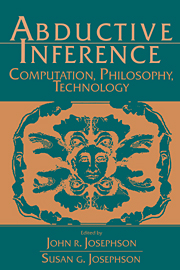Book contents
- Frontmatter
- Contents
- Contributors
- Introduction
- 1 Conceptual analysis of abduction
- 2 Knowledge-based systems and the science of AI
- 3 Two RED systems – abduction machines 1 and 2
- 4 Generalizing the control strategy – machine 3
- 5 More kinds of knowledge: Two diagnostic systems
- 6 Better task analysis, better strategy – machine 4
- 7 The computational complexity of abduction
- 8 Two more diagnostic systems
- 9 Better task definition, better strategy – machine 5
- 10 Perception and language understanding
- Appendix A Truth seekers
- Appendix B Plausibility
- Extended Bibliography
- Acknowledgments
- Index
7 - The computational complexity of abduction
Published online by Cambridge University Press: 08 October 2009
- Frontmatter
- Contents
- Contributors
- Introduction
- 1 Conceptual analysis of abduction
- 2 Knowledge-based systems and the science of AI
- 3 Two RED systems – abduction machines 1 and 2
- 4 Generalizing the control strategy – machine 3
- 5 More kinds of knowledge: Two diagnostic systems
- 6 Better task analysis, better strategy – machine 4
- 7 The computational complexity of abduction
- 8 Two more diagnostic systems
- 9 Better task definition, better strategy – machine 5
- 10 Perception and language understanding
- Appendix A Truth seekers
- Appendix B Plausibility
- Extended Bibliography
- Acknowledgments
- Index
Summary
The problem of abduction can be characterized as finding the best explanation of a set of data. In this chapter we focus on one type of abduction in which the best explanation is the most plausible combination of hypotheses that explains all the data. We then present several computational complexity results demonstrating that this type of abduction is intractable (NP-hard) in general. In particular, choosing between incompatible hypotheses, reasoning about cancellation effects among hypotheses, and satisfying the maximum plausibility requirement are major factors leading to intractability. We also identify a tractable, but restricted, class of abduction problems.
Introduction
What kinds of abduction problems can be solved efficiently? To answer this question, we must formalize the problem and then consider its computational complexity. However, it is not possible to prescribe a specific complexity threshold for all abduction problems. If the problem is “small,” then exponential time might be fast enough. If the problem is sufficiently large, then even O(n2) might be too slow. However, for the purposes of analysis, the traditional threshold of intractability, NP-hard, provides a rough measure of what problems are impractical (Garey & Johnson, 1979). Clearly, NP-hard problems will not scale up to larger, more complex domains.
Our approach is the following. First, we formally characterize abduction as a problem of finding the most plausible composite hypothesis that explains all the data. Then we consider several classes of problems of this type, the classes being differentiated by additional constraints on how hypotheses interact.
Information
- Type
- Chapter
- Information
- Abductive InferenceComputation, Philosophy, Technology, pp. 157 - 179Publisher: Cambridge University PressPrint publication year: 1994
